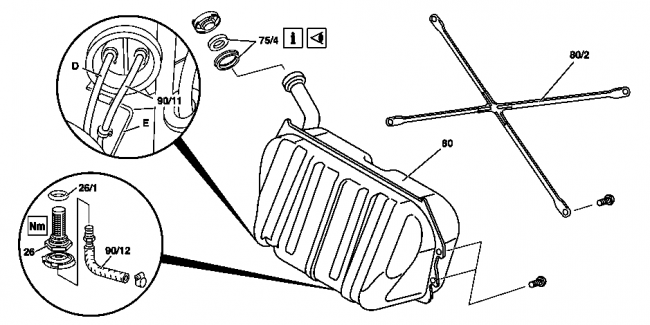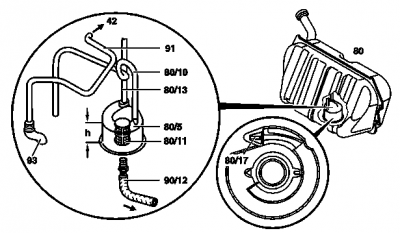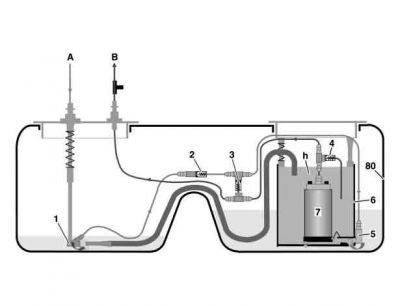Fuel tank: Difference between revisions
| Line 16: | Line 16: | ||
|[[File:W220_A2204707701_fuel_tank_bottom.jpg|thumb|none|A2204707701 (bottom).]] | |[[File:W220_A2204707701_fuel_tank_bottom.jpg|thumb|none|A2204707701 (bottom).]] | ||
|} | |} | ||
=== Location/design/function === | |||
<!-- GF47.10-P-3000K, Fuel tank, location/design/function, 3.6.98 | |||
MODEL 220 with ENGINE 112.922 /944 /972 /975, 113.941 /948 /960 /966, 137.970 | |||
MODEL 215 with ENGINE 137.970 3.6.98 | |||
--> | |||
{| | |||
|[[File:W220_fuel_tank_location_design.png|650px]] | |||
| | |||
Shown without ski bag: | |||
* 26 - Fuel strainer | |||
* 26/1 - O-ring | |||
* 75/4 - Cup seals | |||
* 80 - Fuel tank | |||
* 80/2 - Struts securing fuel tank | |||
* 90/11 - Fuel return hose | |||
* 90/12 - Fuel hose on the suction side with Connection | |||
* D - Fuel tank-activated charcoal canister vent line (shown USA, otherwise with vent valve) | |||
* E - Air admission line for diaphragm pressure regulator in fuel filter | |||
|} | |||
The fuel tank (80) is located in the trunk above the rear axle. | |||
The fuel tank (80) is made of sheet steel. | |||
The fuel is drawn through the fuel strainer (26) in the fuel inlet hose (90/12). | |||
The fuel flows back along the return flow hose (90/11). The vent line (D) runs to the activated charcoal canister (in some cases with vent valve). | |||
== Fuel reserve == | == Fuel reserve == | ||
Revision as of 15:07, 29 September 2021
Fuel tank
W220 has fuel tank (A2204707601) with 88 liter (23 galon) volume, unless vehicle has option code 282 (SKI-BAG) or 308 (REFRIGERATOR IN REAR) in which case the fuel tank (A2204707701) has value of 78 liters (20 galons).
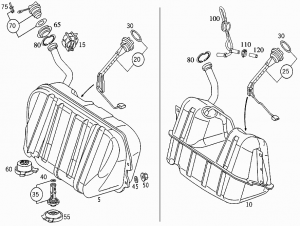
Fuel tank (88l)
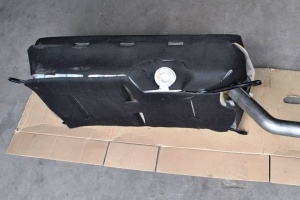 |
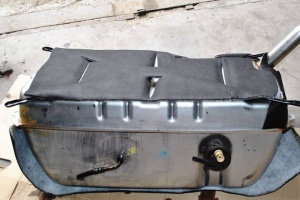 |
Fuel tank (78l)
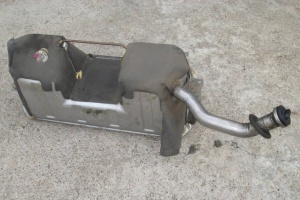 |
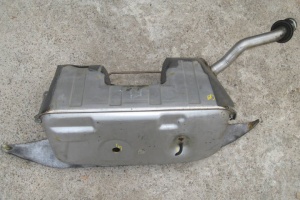 |
Location/design/function
The fuel tank (80) is located in the trunk above the rear axle. The fuel tank (80) is made of sheet steel.
The fuel is drawn through the fuel strainer (26) in the fuel inlet hose (90/12). The fuel flows back along the return flow hose (90/11). The vent line (D) runs to the activated charcoal canister (in some cases with vent valve).
Fuel reserve
The 88 liter tank uses 11 liters as a reserve. The 78 liter tank uses 10 liters as a reserve.
The reserve is what is left when the needle is pointed all the way down to the bottom of the yellow area and the fuel warning light comes on. Hence, the fuel gauge in the instrument cluster shows the fuel level minus the reserve volume.
Splash bowl
The swirl pot is mounted in the fuel tank. The task of the splash bowl is supplying the engine with fuel in the event of a low fuel level in the fuel tank and during lengthy cornering.
The fuel return flow stream flows out of the return flow nozzle (80/17) into the splash bolw at a high velocity when the fuel pump is operated. As a result, the fuel around the return flow nozzle (80/17) is also entrained and carried into the splash bowl.
Fuel level sensor
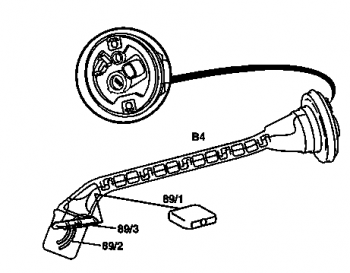
|
|
The fuel level indicator sensor (also known as fuel gauge) is installed in the fuel tank via a bayonet latch.
The task of the sensor is determining the fuel level in the fuel tank. The fuel level sensor (B4) is a lever-type sensor with sliding contacts (potentiometer).
The resistance of the fuel gage sensor (B4) is analyzed in the electronics of the fuel gage. Example model 208: Low resistance = Fuel tank empty, High resistance = Fuel tank full. In the event of a open circuit the fuel gauge in the instrument cluster indicates empty. The fuel reserve warning lamp (A1e4) does not light up.
Fuel tank pressure sensor (USA)
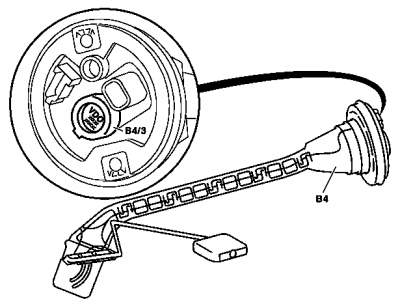
|
Shown on model 210:
|
The fuel tank pressure sensor is built into the hausing of the fuel gauge.
The task for the fuel tank pressure sensor is detecting the internal pressure of the fuel tank for the leak test of the fuel system.
The output signal depends on the pressure inside the tank and is transmitted to the engine control unit.
